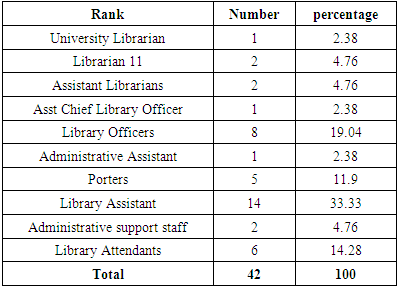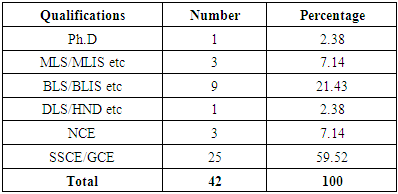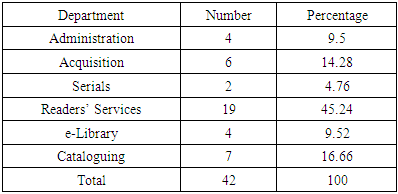-
Paper Information
- Paper Submission
-
Journal Information
- About This Journal
- Editorial Board
- Current Issue
- Archive
- Author Guidelines
- Contact Us
International Journal of Library Science
p-ISSN: 2168-488X e-ISSN: 2168-4901
2020; 9(2): 27-33
doi:10.5923/j.library.20200902.01

SWOT Analysis of the Library of Alex Ekwueme Federal University, Ndufu-Alike, Ikwo, Nigeria
Emmanuel Onwubiko
Alex Ekwueme Federal University, Nigeria
Correspondence to: Emmanuel Onwubiko , Alex Ekwueme Federal University, Nigeria.
| Email: |  |
Copyright © 2020 The Author(s). Published by Scientific & Academic Publishing.
This work is licensed under the Creative Commons Attribution International License (CC BY).
http://creativecommons.org/licenses/by/4.0/

SWOT analysis (Strengths, Weaknesses, Opportunities, and Threats) as a management strategy is a method of assessing a business, its resources, and its environment. The essence of the SWOT analysis is to discover what you do well; how you could improve; whether you are making the most of the opportunities around you; and whether there are any changes in your market. So this evaluation took this dimension to critically analyze the Alex Ekweme Federal University, Ndufu, Alike, Ikwo, Nigeria Library as to knowing what it does well, its weaknesses and threats, identifying the various opportunities that exist within and outside the university environment and how to improve on her weaknesses and overcome her threats as noticed. The analysis, revolved around the 42 staff members of the Library, the collection as well as the electronic resources and other associated infrastructure.
Keywords: SWOT, Strength, Weakness, Opportunity, Threat, University, Collection, Resources and Library
Cite this paper: Emmanuel Onwubiko , SWOT Analysis of the Library of Alex Ekwueme Federal University, Ndufu-Alike, Ikwo, Nigeria, International Journal of Library Science, Vol. 9 No. 2, 2020, pp. 27-33. doi: 10.5923/j.library.20200902.01.
Article Outline
1. Introduction
- Universities as academic institutions are established to advance the intellectual and social condition of the people, the nations and the world through the creation, translation and dissemination of knowledge with emphasis on quality programmes in the areas of teaching, research and service. The aims and objective of any university can be summarized as: facilitation of teaching, learning and research through the provision of facilities, promotion of learning and higher education, promotion of free and quick access to information and facilities and fostering of the spirit of inventiveness (Onwubiko & Uzoigwe 2004).Stating the obvious, no university can achieve her teaching, learning, research and national/human development goal in isolation of a functional library. University libraries therefore play pivotal role in the realization of the tripartite functions of the university. The university library so to speak, is the intellectual power-house of the university. It is the hub, on which every academic activity revolves thus, creates knowledge, conserves it and disseminates it. By so doing, it plays active and invaluable role in the training and education of the citizens and the production of high level manpower as well as the overall development of the society.Inasmuch as the library plays these noble roles, it does not operate as a robot rather these noble roles are initiated and implemented by trained manpower with the availability of required material resources. It is in view of the above assertion, that this study takes a holistic evaluation of both human and material resources of Federal University, Ndufu, Alike, Ikwo, Nigeria Library and their support towards the realization of the library objectives using the SWOT analysis principles as yard stick. SWOT analysis is a planning tool used to understand strengths, weaknesses, opportunities and threats involved in a project/business. Gurel and Tat (2017), describe it as Strategic planning tool which helps an organization to be more productive by helping to guide the allocation of resources in order to achieve goals It is used as a framework for organizing and using data and information gained from situation analysis of internal and external environment (Management Study Guide, 2017). SWOT analysis therefore enables group/individuals to handle everyday problems and look at traditional strategies from a new perspective. To this end, using the SWOT analysis would help the library understands its strengths, that would be helpful in the new venture, its weaknesses that need to be overcome to be useful in future operations, the opportunities that it has at hand to succeed in the near future and the threats that it perceives in the success of the library operations.
1.1. Objectives
- 1. The principle objective of this study is to carry out a SWOT analysis as to establishing the strengths and weaknesses of the entire library system as well as identifying the existing opportunities and threats that are likely to hinder the optimal functioning of the library.2. Suggest ways of enhancing the library functionality and building on the identified opportunities.
2. Literature Review
- The use of SWOT analysis has remained a virile tool for assessing every facet of business organisations, institutions, agencies and departments among others. Despite all its benefits, not much literature has been published on this in the form of research. The library as a growing organism actually needs this strategy at regular intervals in analyzing its strengths, weaknesses, opportunities and threats more so in this era of information and communication technology (ICT).According to Hui (2007), SWOT analysis is a method of assessing a business, it resources and environment. This a good way to better understand a business and its market and can also show potential investors that all options open to, or affecting a business at a given time have been thought about thoroughly. He posits that the essence of the SWOT analysis is to discover what you do well, how you could improve; whether you are making the most of the opportunities around you and whether there are any changes in your market; such as technological development, mergers of businesses or unreliability of suppliers; that may require corresponding changes in your business. Team FME (2013), also corroborated the above assertion as she explained that SWOT analysis is a business analysis technique that your organisation can perform for each of its products, services and markets when deciding on the best way to achieve future growth. The process the teams states involves identifying the strengths and weaknesses of the organisation and opportunities and threats present in the market it operates in. SWOT allows an organization to be more proactive than reactive in shaping its own future; it allows an organization to initiate and influence - rather than just respond to- activities -and thus to exert control over its own destiny (David, 2003) In the opinion of Barney and Hesterly (2006), SWOT as a strategic management in the course implementation makes it possible for organization to adopt organizational policies and practices that are consistent with its strategy with the aim of obtaining competitive advantage. The primary objective of a SWOT analysis is therefore as averred by Schooley (2019), is to help organizations develop a full awareness of all the factors involved in making a business decision. He added that this method was created in the 1960s by Albert Humphrey of the Stanford Research Institute, during a study conducted to identify why corporate planning consistently failed and since then, SWOT has become one of the most useful tools for business owners to start and grow their companies.In the views of Ahmand (2011), SWOT analysis indicates a framework for helping the researchers or planners to identify and prioritize the business goals, and to further identify the strategies of achieving them. SWOT analysis is a technique used to analyze the strengths, weaknesses, opportunities and threats of businesses. A SWOT analysis can help them gain insights into the past and think of possible solutions to existing or potential problems, either for an existing business or for a new venture (USDA, 2008; Nouri et al., 2008). Thompson et al., (2007) reveal that SWOT Analysis is a simple but powerful tool for sizing up an organization’s resource capabilities and deficiencies, its market opportunities, and the external threats to its future. To be specific, SWOT is a basic and candid model that assesses what a business can and cannot do, as well as its potential opportunities and threats. The method of SWOT analysis is to take the information from an environmental analysis and separate it into internal (strengths and weaknesses) and external issues (opportunities and threats). Once this is completed, SWOT analysis determines what may assist the firm in accomplishing its objectives, and what obstacles must be overcome or minimized to achieve the desired results (Singh, 2010).Writing on the merits of SWOT, Team FME (2013) opines: the popularity of its analysis is down to its simplicity and flexibility; it is easy for everyone to understand and its implementation does not require any technical knowledge or specialist training and the methodology can condense a large number of situational factors into manageable number. Contributing on why SWOT analysis is important Status net (2020) posits that SWOT Analysis causes business leaders to stop what they are doing and assess where the company is going. It is the hallmark of a strategic plan, and it enables leaders to sit down with all internal stakeholders to discuss the short and long-term goals of the company. Where this tool really shines is the opportunities and threats. Throughout the busy work day and meetings, it can be easy to forget to assess chances the company has to grow. Going through the SWOT process allows leaders to take the time to not lose out on any lucrative opportunities. SWOT is a large part of the strategic planning process, but many leaders are not utilizing this tool for various reasons.
3. Research Methodology
- The study will apply descriptive survey research design which according to Nworgu (2015) is a type of study which aims at collecting data on and describing in a systematic manner the characteristics features and facts about a given population. This type of study is only interested in describing certain variables like dependent and independent variables in relation to the population.
3.1. Area of Study
- Alex Ekweme Federal University Ndufu – Alike, Ikwo, Ebonyi State, Nigera is one of the nine Federal Universities that were set up by Former President of Nigeria, Dr. Goodluck Ebele Jonathan (GCFR) on February 26, 2011 in order to expand access to quality education to all parts of Nigeria and to produce knowledge that will support the nation’s economy and its industries. The University library which took off in March, 2013 has in his collection as at the time of this evaluation 13000 volumes of books made up of 7225 titles and approximately 2700 volumes of both local and foreign journals in print, 300 titles of institutional repository covering students’ projects and staff publications.
3.2. Methods for data collection/Analysis
- Data for the study were collected through document analysis and observation. These gave the researcher the opportunity to obtain firsthand information about the library operations as well as having physical assessment of both materials and human resources of the library.The data collected were analyzed using descriptive statistics which in the words of Agu (2014) refers to the statistical procedures that are used to describe and summarize data for easy comprehension. This implies that data will be organized and analyzed based on the research questions using documentary research method, frequency tables, percentages, charts/graphs.
4. Data Presentation
- The library sitting capacity presently is 250 while the library can boast of 45 computer sets with 41 in the e-library and 4 for the OPAC. These computers are not part of other 11 computer sets and the server mainly used for administrative purposes and in-house technical services. There are also 3 functional scanners, 3 there-in-one printers, 1 LaserJet printer and 1 modern gigantic digital photocopier.
4.1. STAFF
- The library has staff strength of 42 classified generally in the following groups: Professional/Academic librarian; Para-professional librarians; Administrative staff and Junior/ support staff. In a broad arrangement the entire staff is placed in the following positions:Staff position
|
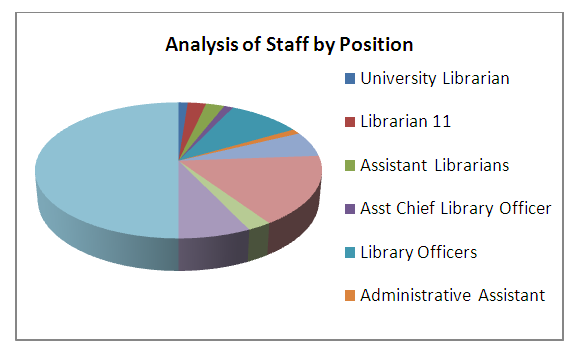 | Figure 1. Staff Position |
|
 | Figure 2. Analysis of staff by profession |
|
 | Figure 3. Analysis of staff by promotion |
|
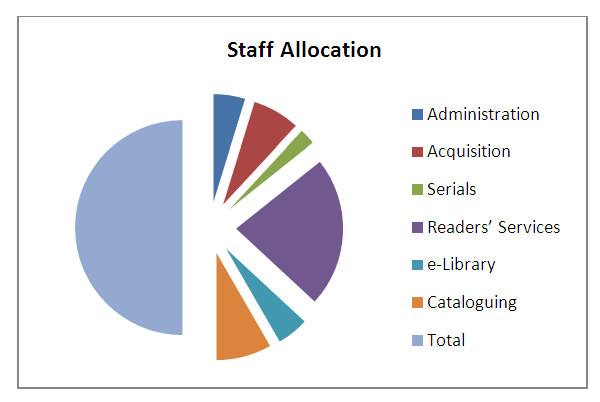 | Figure 4. Staff by department |
4.2. Functions of Each Department
4.2.1. Administrative Unit
- This unit of the library is headed by the University Librarian who by promotion and placement is a professor and a principal staff officer of the university. He is being assisted by an Administrative Assistant posted from the office of the Registrar. This unit sees to the day-to-day running of the library as they concern administrative paper work which include; staff welfare, liaising with the university Administrators on matters relating to funding and provision of necessary tools for the smooth running of the library in general. The unit also has a Finance Officer posted from the Bursary Department of the university whose job is mainly to handle and process the library financial transactions. Invariably, the officer is the link between the library and the bursary. The unit has two office assistants who are of the rank of library Assistants.
4.2.2. Acquisitions/Gift Unit
- As the name denotes the department is in-charge of all procurement in the library as well as control and acceptance of gifts and books donated. This department actually does the selection, ordering and processing of books both manually and electronically. The Librarian in-charge of the unit operates the Acquisition Module of the Integrated Library System (ILMS) assisted by two Library Officers and assents to all acknowledgement and letters of Appreciation sent to donors. The department is headed by a Chartered Librarian.
4.2.3. Serials Unit
- This is the smallest unit of the library. It has only two staff: the Assistant Librarian who is in-charge and a Library Assistant. The Unit is responsible for the procurement and processing of all serials including daily newspapers needed both by the University management and the general users of the library. The serials module is also part of the ILMS and is used to process and input acquired serials electronically into the database.
4.2.4. Readers’ Services Unit
- The Readers’ Services Unit also called the Circulation Department is in fact the eye of the Library. This is because, it is the only unit of the library that deals directly with the public (Library users). The Porters’ lodge which is the first port of call for all users is directly under the control of this Unit and the staff acts as the image makers of the library in that any behaviour exhibited by any of the staff can make or mars the library before the University management and the general public. The Unit is responsible for charging and discharging of books in circulation. It maintains accurate records of library users through library registration, and keeping records of all that used the library on daily basis. The Unit also ensures the safety of all library collections in circulation and Charges fees for defaulters of the library rules as stipulated in the library policy. The Head of the Unit who is a Chartered Librarian assisted by the Unit Library Officers also oversees to the operation and up-dating of the Circulation Module of the ILMS.
4.2.5. Classification/Cataloguing Unit
- The Classification and Cataloguing Unit of the Library is a follow-up of the acquisition Unit. The act of processing the various information materials acquired by the Acquisition Unit stops at assigning accession numbers to them both manually and making the first entry in the Acquisition Module. After this first stage of processing carried out by the Acquisition Unit, the other part of technical services which is arranging the books in their similarities and carrying out the bibliographic descriptions of these materials are done by this Unit. This Unit is the only one in the Library that is headed by a Para-professional: Assistant Chief Library Officer (ACLO). Apart from three Library Officers, the ACLO has three Library Assistants working under him. The Unit apart from using the Cataloguing Module for her day-to-day technical services, is also responsible for up-dating and managing the Library OPAC.
4.2.6. E-Library
- The e-library by nomenclature refers to a library system that is entirely virtual in nature and operation. In the case of FUNAI library, this refers to all e-resources of the library. These include: the databases, server, CD-ROMs, OPAC and the room housing the computer systems that are networked and connected to the internet. To this end the System Librarian who is the head of the Unit ensures the functionalities of all the equipment and resources. The unit works hand-in-hand with ICT unit of the University. The systems Librarian is supported by three other junior staff of the rank of Library Assistants but are computer literate.In a broad term, all the Unit Heads are members of the University Library Management Committee and they decide the way forward for the library as they sit bi-weekly.
5. Data Analysis
- In line with the objectives of this study which is to carry out a SWOT analysis as to establishing the Strengths, Weaknesses, Opportunities and Threats of the University Library, the discussion of the findings were therefore based on SWOT principles.
5.1. Strengths
- The major strengths of the library lie on her staff and collections. The library has very highly qualified Librarians and Library Officers. In fact, the University Librarian is a seasoned librarian who once was the University Librarian of the famous University of Lagos, Nigeria. Three of the Unit Heads have almost completed their doctorate programmes in Library and Information Science in various first generation universities in Nigeria while the Chief Library Officer who holds a Master’s degree in English Language has completed his course work for the degree of Master’s in Library Science. Above all, they are highly competent in computer handling and application in all packages. It is also pertinent to state that the 5 Librarians are Chartered Librarians. On the part of the Library Officers, 6 out of 8 which is 75% are at one stage or the other in their Masters’ degree programme in Library and Information Science in Nigerian Universities, While the one with HND has almost rounded off his PGD programme in Library Science. Furthermore, 2 of the Library Officers are chartered Librarians. The library collection is another area of strength in that the library maintains a strong selection policy that hinges on ‘if not the best print from world class and renowned academic publishers with the most recent edition do not acquire unless in special cases’. So of the over 13000 volumes book, 75% of them are of international standard in print and content. The Library OPAC though operated with only 4 computer system is almost 24/7 up this you hardly see even in most first generation universities in Nigeria.
5.2. Weaknesses
- A major weakness of the library is her non-provision of Catalogue Card Cabinet. The implication is that the students find it very difficult to access the books on the shelves. It is true it has the OPAC; this in no way plays the role of the card catalogue which is systematically arranged in the cabinet and made very visible in the library unlike the OPAC which is too far away from the main library collection.Another major weakness is that of inadequate reading space. The university with a population strength of 5670 including staff and students with a library that has a reading space for only 250 persons, falls below standard. Furtherance, the library building does not befit a world class university as the university is christened.
5.3. Opportunities
- The library is faced with so many opportunities; in the first instance, there are apple rooms for training of staff. The present crop of staff in the library are pioneer staff and they have this grace of accessing the Tertiary Education Trust Fund (TETFUND) for staff training, there is also window for in-house training and re-training and privileges to attend university sponsored conferences and workshops.The other area of opportunity is research; in the Nigerian context every academic librarian is a researcher. To this end, the staff is at liberty to embark on researches on areas of interest. These researches apart from being tools for promotion on the part of the staff is also better way of marketing the library as well as creation and dissemination of knowledge.The library can also go into Selective Dissemination of Information (SDI) and Current Awareness Services (CAS) as both staff students are ready to pay for such services as long as they meet their information needs. By so doing, the internally generated revenue (IGR) of the library will be enhanced. The library can even go a step further by inaugurating an academic Journal publication and call for external papers in which authors will be charged fees for having their works reviewed and published.The other glaring opportunity in the library is the establishment of a bindery section or unit as the case may be. This has become imperative as the university has started graduating students and their projects ought to be bind based on the university standard and the library with a bindery unit will serve this purpose better. The unit will also accrue a lot of revenue for both the library and the university. Within, the library, it will also save a lot of time and money as those torn and mutilated book and newspapers due to be bound will now be done by the library at a cheaper cost and lesser time.With increase in students’ population, the gain of establishing a commercialized photocopying centre becomes imperative. Such a project within the library no doubt will be money spilling and a plus to the IGR.
5.4. Threats
- A very noticeable threat facing the library is inadequate security for library materials as there are no security gadgets installed to monitor users neither do they have enough manpower to monitor the activities of the students and other library users. In fact security wise, the entire library is porous and the materials are prone to be stolen. Worst still, there is no synergy between the university security unit and the library management.A follow up to security is the problem of safety; the library was built without consideration for safety of both staff and students in the case of emergency. The truth is that the library has one door for entrance and exit in which case, a situation where there is fire out break as have been noticed in many Nigerian Universities, the library users would be left to their own fate.
5.5. Conclusions and Recommendations
- In indeed, the university library has great strengths and promising opportunities, but when compared to the identified internal weaknesses and external threats, one is left gasping and to conclude that a lot needs to be done by the Library Management if she is hoping to stand out and sing in the near future ‘we have arrived. Let attention be focused on the identified weaknesses and threats, while opportunities recognized are utilized to the fullest. In the light of the above, the following recommendations are made:Ø Staff of the library should be well motivated as monthly salary is not in the present era seen as the major tool of motivation. Library Management should create effective window of communication and free flow of management policies as to creating the desired rapport. When this is done, staff will have that sense of belonging and will be ready to deliver.Ø The Library Management should build on earlier enumerated strength and utilize the opportunities pinpointed to the fullest.Ø As a matter of necessity, the library management should make hay to provide catalogue card cabinet with well fitted catalogue card for each print title in her collection.Ø The gain of cataloguing and indexing journals cannot be overemphasized, therefore, the journals should be catalogued and if possible indexed for easy accessibility and there is also the need to create a separate room for storage and reading of serials.Ø The Library should without much ado, set up a bindery unit.Ø There is also the need to establish a photocopying centre by the library apart from the IGR; it will also help library users utilize properly through the reprographic service, those reserve titles that cannot be taken on loan by users.Ø On security and safety, the library management should install CCTVs to monitor users’ activities as well as train staff on safety management and also create another route for emergency exit in the case of fire out break or any criminal attack.
 Abstract
Abstract Reference
Reference Full-Text PDF
Full-Text PDF Full-text HTML
Full-text HTML